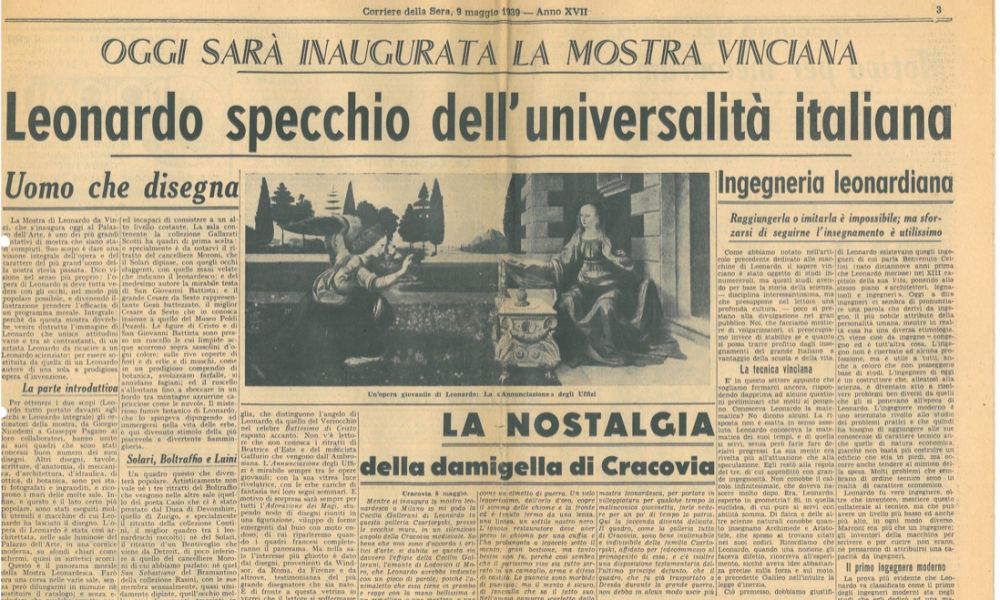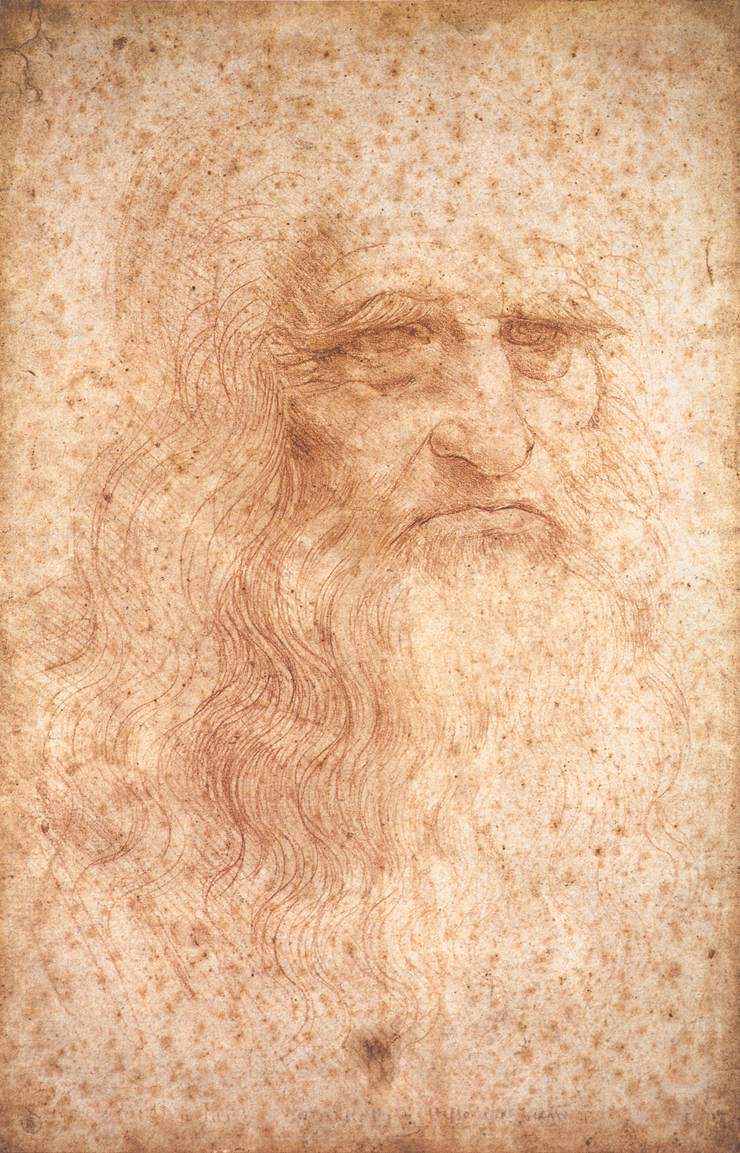On the myth of Leonardo da Vinci's Italian genius from the nineteenth century onward.
The tedious and futile nationalist polemics on theItalianity of Leonardo da Vinci, which from time to time are rekindled as a result of the unhinged interventions of some politician in search of easy stereotypes or some boutade that has more to do with stadium cheering than with culture, risk losing sight of the value of Leonardo’s art according to its historical perspective, and on the basis of its universal scope. And to say that at the very beginning of 2018 a conference was held at the National Museum of Science and Technology in Milan (which is dedicated precisely to Leonardo da Vinci), aimed at precisely redefining “the contours of the historiographic image of Leonardo da Vinci” that came into being after the Leonardo da Vinci and Italian Inventions Exhibition, promoted in 1939 by the fascist regime more for propaganda purposes than for cultural reasons. Yet, the inauspicious echo of that exhibition still resonates whenever there is a tendency to present the Tuscan artist as a genius capable of demonstrating the supremacy of Italians in the sciences and arts. And if the myth of “Leonardo da Vinci the Italian genius,” at the origin of a tradition that was intended to start from the Renaissance and go all the way back to Guglielmo Marconi’s inventions, might even be tolerated if limited to the sphere of joking jokes about national stereotypes, it begins to turn into something dangerous if it starts gaining political weight (think of cultural exchanges between states, or international loan policies between museums).
 |
| Article from the Corriere della Sera, 1939, with news of the opening of the Leonardo exhibition |
 |
| The layouts of the 1939 exhibition |
The Leonardo myth was somewhat fabricated during the years of Fascism, but it rests its foundation on phenomena that arose well before the Ventennio. The January 2018 conference (unequivocally titled Leonardo 39. The Construction of a Myth, which was then followed by an exhibition with the same title, which concluded on June 20, 2018), through Marco Beretta of the University of Bologna and his paper Leonardo in the Historiography of Italian Science. 1797 - 1939, remarked on the stages that led to nurturing Leonardo’s fame to the point of making him a figure with almost sacred, mythological connotations. The first step was identified in the arrival in France of Leonardo’s codices from the Biblioteca Ambrosiana in Milan, brought to Paris by Napoleon: if in the Lombard capital these precious documents had almost been forgotten, in France they began to be held in high esteem by scholars, so much so that in 1797 the Reggio physicist Giovanni Battista Venturi drew up an Essai sur les ouvrages physico-mathématiques de Léonard de Vinci, avec des fragmens tirés de ses manuscrits, apportés de l’Italie, written in French and published by Duprat in Paris. In the treatise, Leonardo was placed “at the head of those who have been concerned with the psycho-mathematical sciences and the true method of study among the moderns,” and it was regretted that his treatises had been discovered late: Venturi believed that modernity would have begun earlier if Leonardo’s treatises had enjoyed greater consideration. After the fall of Napoleon, the codices in the Biblioteca Ambrosiana returned to Milan and this time were also examined by Italian scholars, and Leonardo’s name began to receive increasing attention: it is above all the versatility of his work that holds sway, especially in the aftermath of the publication, in photographic reproduction, of all his codices found in France, edited by Charles Ravaisson-Mollien in the 1880s, and followed closely by the publication in Italy of the Codex Trivulzianus (1891), the Codex on the Flight of Birds (1893) and the Codex Atlanticus (between 1894 and 1904).
And it was towards the end of the 19th century that the foundations were laid for the exaltation of Leonardo. His myth, wrote scholar Roberto Cara in a recent essay dedicated to the aforementioned 1939 exhibition(La mostra di Leonardo da Vinci a Milano tra arte, scienza e politica, included in All’origine delle grandi mostre in Italia (1933-1940), a volume edited by Marcello Toffanello and published in 2017 by Il Rio Editore), “had been enriched between the nineteenth and twentieth centuries with new qualifying elements; positivism, decadentism and symbolism had cast a new and sometimes contradictory gaze on the Florentine master, helping to fuel his fame: he had not only been a great artist but also an unparalleled ’scientist’ and inventor; this appeared of fundamental importance in the ’century of technology,’ in a nation resonating with the watchwords of futurism, adopted by the regime. This was proved by his manuscripts, dense with annotations, technical and anatomical drawings, systematically published since 1880.” However, Cara points out, it is still unclear why it was precisely Leonardo who was chosen for the celebrations, but the aims of the exhibition are clear if one reads the statement of intent contained in the “General Regulations” of the Milanese exhibition: “the purpose of the exhibition is to celebrate the universal and unparalleled genius of Leonardo da Vinci, assumed almost as a symbol of the entire Latin and Christian and therefore Roman civilization, and to highlight the spiritual ties that unite this great realizer and creator to the achievements of Mussolini and imperial Italy. Labbinamento to the vincian celebration of the exhibition of Italian inventions tends to demonstrate the continuity of the creative genius of the lineage and the great possibilities open to it in the climate of the fascist will.” In essence, if the “genius” of Leonardo da Vinci began to be the object of profound admiration from the end of the eighteenth century, it was with the fascist regime (and with that exhibition, which Roberto Longhi moreover called “abominable”) that the Leonardo myth took on the proportions of a national pride.
 |
| Leonardo da Vinci, Dome Portrait known as Self-Portrait (c. 1515; sanguine on paper, 33.5 × 21.6 cm; Turin, Biblioteca Reale) |
Yet, prejudices about Leonardo persist over time: it is a vain and idle undertaking to enumerate the occasions when Leonardo’s knowledge has been juxtaposed with an idea of the primacy of Italian-ness that was as nonexistent then as it is today. It is necessary, therefore, to give Leonardo da Vinci back his historical and cultural dignity, and the first fixed point, which might seem obvious in the eyes of insiders or those who are well acquainted with Leonardo’s work, but not so much to those who grew up with the myth of the isolated genius whose insights seem as if lowered from above, is the reinsertion of Leonardo in his context. For example, as Pietro C. Marani and Maria Teresa Fiorio in the introduction to the exhibition on Leonardo held in 2015 at the Palazzo Reale (one of the stated intentions was precisely to unhinge the mythographic vision that sees him as an extraordinary individual detached from his time), Leonardo’s passage to Verrocchio’s workshop and contact with the artistic reality of the Florence of the time, certainly accentuated what was “a predisposition to extend one’s curiosity toward all aspects of artistic production and craftsmanship and to observe, and then to reproduce analytically, all the varied elements and phenomena that offered themselves to vision.” and education alongside such a versatile artist as Verrocchio, who was a painter, sculptor and goldsmith, had encouraged the young Leonardo “to an objective analytical view of nature and things, supported by knowledge of geometry, mathematics and perspective and an exceptional manual dexterity, out of the ordinary.” Again, think of the celebrated Vitruvian Man, often the subject of the most disparate interpretations and aimed at extracting who knows what secrets from this work, which in reality, as has also been discussed on these pages, is perfectly cast in the cultural reality of the last glimpses of the fifteenth century and is a work that is anything but isolated. And one could not explain Leonardo’s interest in the elaboration of a new scientific method, if one did not frame his will in the context of his studies that led him to deepen his knowledge of ancient and medieval mechanics, or simply if one did not also take into account the level at which technological progress had reached in his time. Leonardo was animated by a sort of desire to reform the science of weights, as well as by “the intention of extending its scope to ever broader disciplinary fields,” so that his attitude was that of "the artificer who is not content to contemplate the scientia de ponderibus as an elegant product of abstract speculation, but sets out to use its theorems on the practical plane“ (Paolo Galluzzi). And again, many of his ”inventions" are nothing more than reworkings of technologies that already existed, or meditations on insights provided by other engineers and artists of the time, such as Francesco di Giorgio Martini or Bonaccorso Ghiberti. More than the inventions themselves, what matters is the inquisitive approach of Leonardo, who in this sense was a pioneer of modern scientific thought.
As for Leonardo da Vinci’s a priori Italian-ness, it is perhaps superfluous to reiterate that at the time Leonardo was referred to by his contemporaries as “Florentine Leonardo da Vinci” (a formula we find in official documents, contracts, and the writings of contemporaries), that the concept of the Italian nation, though considered by many scholars to be in nuce at the time, was not felt by the artist, and that it is therefore a historical stretch to want to attribute the label of “Italian” to Leonardo da Vinci if for the purpose of setting him up as an example of the virtues of the Italian nation (net of the obvious simplifications, of purely geographical significance, that lead us to define “Italian” everything that happens on this side of the Alps). At most, we can consider him as one of the pivotal figures of that shared Italian culture that has been shaped, however, since the 19th century. And it is useful to emphasize that already in the nineteenth century readings spread that, albeit with the limits imposed by their historical context, were aimed at framing Leonardo’s genius not as belonging to a nation and therefore liable to acquire a specific citizenship, but rather as the heritage of all humanity. The French historian Edgar Quinet, for example, found the roots of Leonardo’s universality in the attitude of the humanists who lived a few decades before him: used to give themselves a Latin name (and thus, to a certain extent, to sever ties with their “homeland”), in the same Florence they united in the name of Plato’s philosophy, thus finding a sort of continuity with ancient Greece and extending their cultural horizons in the midst of a tradition that had no national character. Horizons whose witness would later be passed on to artists such as Leonardo, Raphael and Michelangelo, already considered as no longer representative of Italy alone, but of all humanity. And again, the pioneering Ricerche intorno a Leonardo da Vinci, published by Gustavo Uzielli in 1872, devoid of any nationalist rhetoric, identified Leonardo as “one of the most singular phenomena that humanity has manifested in its incessant evolution.” Leonardo’s greatness, in the final analysis, lies neither in his geographical provenance nor tout court in his inventions: it lies, if anything, in the value of his art and his uncommon ability to interpret and observe reality.
Warning: the translation into English of the original Italian article was created using automatic tools. We undertake to review all articles, but we do not guarantee the total absence of inaccuracies in the translation due to the program. You can find the original by clicking on the ITA button. If you find any mistake,please contact us.





























